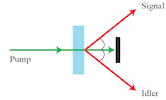Quantum entanglement – the ability to infer information about one particle by a distant measurement of a second – is one of the defining properties of quantum mechanics, famous for giving a “spooky” link between distant objects [1].
Entanglement forms the basis of quantum information and quantum computing and is essential for applications such as entangled cryptographic systems and quantum imaging.
Spontaneous parametric down-conversion (SPDC)

Pump photon is converted into 2 lower frequency photons.

Conservation of energy & momentum in SPDC.
Spontaneous parametric down-conversion (SPDC) is the generation of two lower- frequency photons when a pump field interacts with a nonlinear crystal. It is a conservative process: energy, momentum and orbital angular momentum are all conserved.
SPDC has been shown to be a reliable source of photons that are entangled [2], in particular, in their orbital angular momentum (OAM) [3]. The spatial structure of the down-converted biphotons can be expressed as a superposition of Laguerre–Gauss (LG) modes of different amplitudes, angular and radial momenta, with the width of the modal expansion relating to the amount of entanglement of the final state [4, 5, 6].
[1] A. Einstein et al., Phys. Rev. 47, 777 (2002).
[2] C. K. Hong and L. Mandel, Phys. Rev. A 31, 2409 (1985).
[3] A. Mair et al., Nature 412, 313 (2001).
[4] J. P. Torres et al, Phys. Rev. A 68, 050301(R) (2003).
[5] F. M. Miatto et al. Phys. Rev. A 83, 033816 (2011).
[6] A. M. Yao, New J. Phys. 13 053048 (2011).